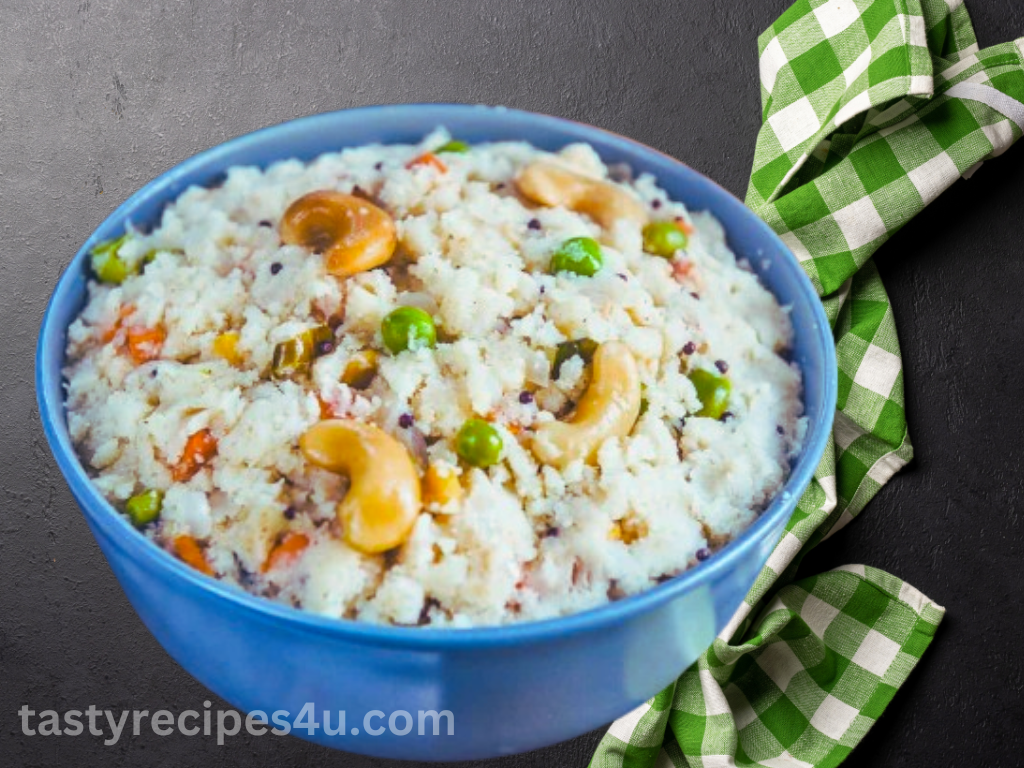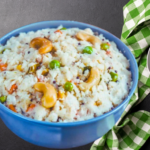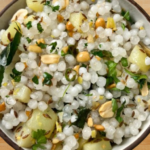Upma Recipe
Upma, a beloved South Indian dish, holds a special place in the hearts and palates of many. This versatile and comforting meal, made primarily from semolina and an array of aromatic spices and vegetables, is not only delicious but also simple to prepare. Whether enjoyed as a hearty breakfast, a light lunch, or a satisfying dinner, Upma never fails to deliver on flavor and nourishment. In this comprehensive guide, we’ll delve into the origins of Upma, its essential ingredients, step-by-step instructions for preparation, and a treasure trove of tips and tricks to elevate your Upma game to new heights.

About Upma Recipe
Upma traces its roots to the southern region of India, particularly Tamil Nadu, where it is known as Uppuma or Uppittu. Over the centuries, Upma recipe has transcended regional boundaries and become a beloved dish across the Indian subcontinent. Its simplicity, versatility, and wholesome flavors have contributed to its widespread popularity. Today, Upma recipe is enjoyed not only in South India but also in other parts of the country and around the world, making it a true culinary gem with universal appeal.
How to make Upma Recipe
Ingredients for Upma Recipe
Before we embark on our Upma-making journey, let’s gather the essential ingredients:
- 1 cup semolina (rava/sooji)
- 2 tablespoons oil or ghee
- 1 teaspoon mustard seeds
- 1 tablespoon black gram dal (urad dal )
- 1 tablespoon Bengal gram (chana- dal )
- 8-10 curry leaves
- 2 green chilies, finely chopped
- 1-inch piece ginger, minced
- 1 small onion, finely chopped (optional)
- 1 small carrot, finely chopped (optional)
- 1/4 cup green peas (optional)
- 1 small finely chopped bell pepper (optional)
- 2 1/2 cups water
- Salt to taste

Now that we have our ingredients assembled, let’s dive into the step-by-step process of making Upma Recipe : Step-by-Step Preparation:
Step 1: Dry Roast the Semolina:
Set a skillet or pan with a thick bottom over medium heat. Add the semolina to the pan and dry roast it, stirring constantly to prevent burning. Roast the semolina until it turns golden brown and emits a nutty aroma, which typically takes about 5-7 minutes. Take out the roasted semolina in a separate plate.
Step 2: Prepare the Tempering:
Heat the oil or ghee in the same pan over medium heat. Once the oil is hot, add mustard seeds and allow them to splutter. Then, add urad dal and chana dal, and sauté until they turn golden brown and aromatic. Add curry leaves, chopped green chilies, and minced ginger, and sauté for another minute to release their flavors.
Step 3: Sauté the Vegetables (Optional):
If using vegetables for Upma recipe , such as onions, carrots, peas, or bell peppers, add them to the pan with the tempering. Sauté the vegetables until they are tender yet crisp, adding a delightful texture and freshness to the Upma.
Step 4: Cook the Semolina:
Return the roasted semolina to the pan with the tempered spices and vegetables. Mix well to combine, ensuring that the semolina is evenly coated with the aromatic mixture. Gradually pour in the water while stirring continuously to prevent lumps from forming. To taste, add the salt and mix well.
Step 5: Simmer and Serve:
Switch to medium-low heat and place a lid on the pan. Allow the Upma to simmer for 3-4 minutes, or until the semolina has absorbed the water and reached a soft, fluffy consistency. Once cooked, remove the lid and fluff the Upma with a fork to separate the grains.
Step 6: Garnish and Enjoy:
Transfer the Upma to serving plates and garnish with freshly chopped cilantro leaves for a burst of color and freshness. Serve hot with a side of coconut chutney, pickle, or yogurt for a complete and satisfying meal.
Tips and Tricks for Perfect Upma
- Use coarse semolina for the best texture and mouthfeel in Upma.
- Adjust the quantity of water based on your desired consistency—some prefer their Upma soft and moist, while others prefer it drier and fluffier.
- For extra flavor, dry roast the semolina with a tablespoon of ghee before adding it to the tempering.
- Add a pinch of turmeric powder to the tempering for a vibrant yellow color and subtle earthy flavor.
- For a protein boost, add roasted peanuts or cashew nuts to the Upma during the tempering stage.
- Serve Upma with a squeeze of lemon juice for a refreshing citrusy twist.
- Experiment with different spices and herbs such as cumin seeds, fennel seeds, or fresh coriander for unique flavor variations.

FAQs (Frequently Asked Questions):
Q: Can I use different vegetables in Upma recipe?
A: Absolutely! Upma is incredibly versatile, and you can customize it with your favorite vegetables such as tomatoes, potatoes, spinach, or even mushrooms.
Q: Can I make Upma in advance?
A: While Upma is best enjoyed fresh, you can prepare the tempering and roast the semolina in advance to save time. Simply combine the two when ready to cook and follow the remaining steps as usual.
Q: Can I make Upma recipe without oil or ghee?
A: Yes, you can make Upma recipe without oil or ghee by dry roasting the semolina and tempering the spices in a non-stick pan or using a small amount of water or vegetable broth for sautéing.
Q: How do I prevent lumps in Upma?
A: To prevent lumps in Upma, ensure that the roasted semolina is well-coated with the tempered spices and vegetables before adding the water. Stir continuously while pouring in the water to achieve a smooth and lump-free texture.
Conclusion
With these tips and tricks in your culinary arsenal, you’re well-equipped to embark on your Upma-making journey with confidence. Whether you’re a seasoned chef or a novice in the kitchen, Upma is sure to delight your taste buds and leave you craving more with each comforting bite. So go ahead, gather your ingredients, and let the aromatic aromas of Upma fill your kitchen with warmth and joy. Happy cooking!


